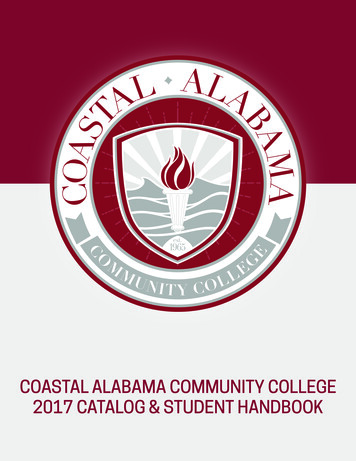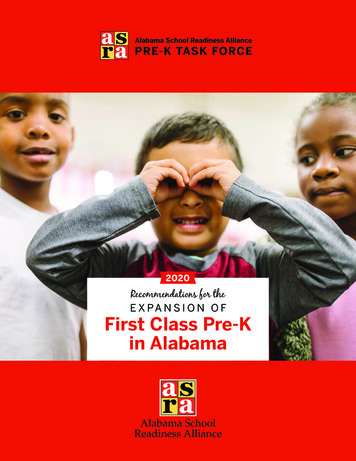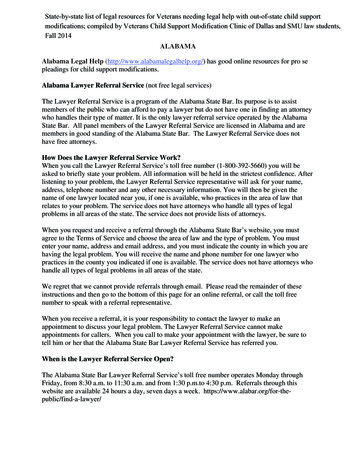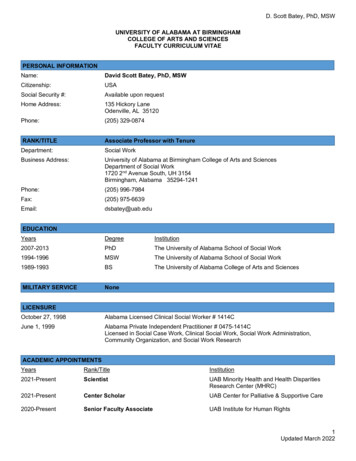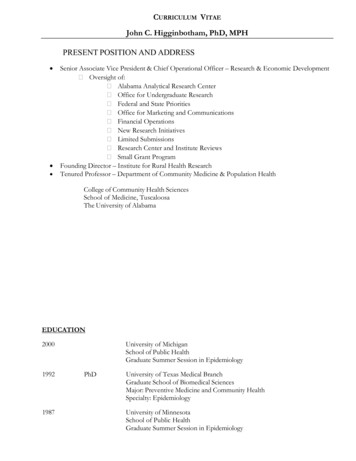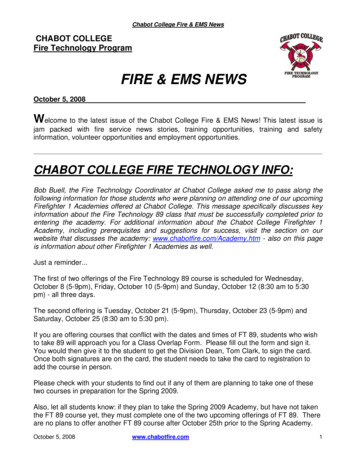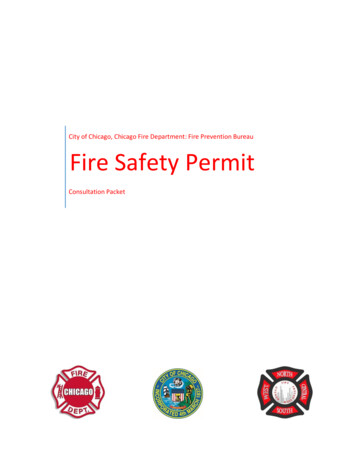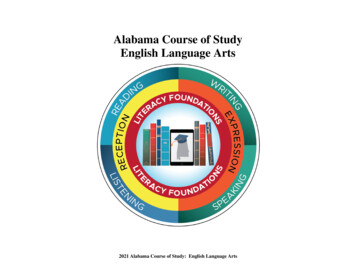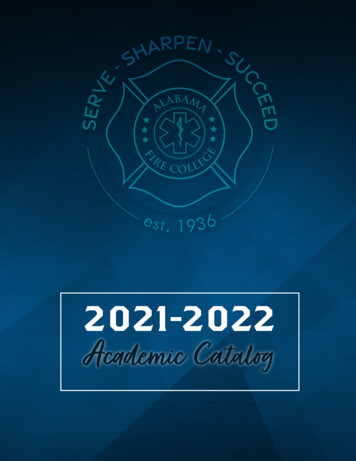
Transcription
Alabama Fire College and Personnel Standards and Education Commission2501 Phoenix Drive, Tuscaloosa, Alabama 35405Information: 1(800)241-2467 www.alabamafirecollege.orgBookstore: 1(866)984-3545 www.afcbookstore.comNormal operational hours for the Alabama Fire College main campus are Monday through Friday, 7 am to 5 pm. The bookstoreis open 7 am to 4 pm, but hours may vary as needed.The Alabama Fire College is accredited by the National Board on Fire Service Professional Qualifications (ProBoard) and theInternational Fire Service Accreditation Congress (IFSAC).For an interactive map and directions to our main campus, Regional Training Centers, and Extension Training Centers, visit usonline at www.alabamafirecollege.org/map.Mission:Our continuing commitment is to facilitate excellence in education, training, certification, and support services for theemergency response community.Vision:We, the Alabama Fire College, will be the answer to the needs of the fire and emergency service community.Rev. August 2021Table of Contents2Alabama Firefighters Personnel Standards and Education Commission3A Message from the Executive Director3Organization History and Overview4Campus Map5Facility Locations: Main Campus & Training Centers6-8Certification Information9-14Student Admissions and Attendance Policies15-16Veterans’ Information17-25Fire Science Curricula26-32Emergency Medicine Curricula33EMS Curriculum Class Hours34-35Tuition & Fees Table
Personnel Standards and Education CommissionThe Alabama Firefighters’ Personnel Standards and Education Commission was established by Section 36-32-2 of the Code of Alabama 1975and is made up of seven appointed members. As of April 17th, 2012, the Governor and Lieutenant Governor each appoint one member. TheAlabama Firefighters’ Association, The Professional Fire Fighters of Alabama, Alabama Association of Fire Chiefs, and the Alabama Associationof Volunteer Fire Departments each appoint one member. The State Fire Marshal serves as a member by virtue of his position. All appointeesmust receive confirmation from the Alabama Senate. Among other duties established by law, the Commission certifies individual firefightersmeeting the minimum standards established, as well as training and education programs for the fire service in Alabama.Chairman: Joey Darby began his fire service career in 1992 as a member of the Walnut Hill Volunteer Fire Department inWalnut Hill, FL. He joined the Auburn Fire Division in 1994 and rose to the rank of Battalion Chief before leaving to assumehis present duties as the Fire Chief of the City of Foley in January 2009. He also served as the Fire Chief of the StillWaters FireDistrict from 2005 through 2008. He has a Bachelor of Science Degree in Agricultural Engineering from Auburn University andhas completed numerous executive classes at the National Fire Academy. Chief Darby was elected in 2013 to represent theAlabama Association of Fire Chiefs as their first appointment on the Commission. Current Term Expires: 2/11/2022Commissioner Gary Sparks began working for the City of Oxford at the fire station in 1978 when he was 15 years old cleaningthe station and trucks. Chief Sparks became a Volunteer Firefighter for the City of Oxford in 1983. On February 13, 1987, ChiefSparks became a full time member of the Anniston Fire Department. Chief Sparks rose through the ranks at Anniston and waspromoted to Assistant Fire Chief on January 3, 2003. He retired after 20 years of service with the Anniston Fire Departmenton February 13, 2007. On March 3, 2007, he became the full time Fire Chief for the City of Oxford. Chief Sparks is involved inseveral civic organizations in his community. He is currently the 1st Vice President of the Alabama Fire Chief’s Association andwas voted the 2015 Alabama Fire Chief of the Year. Current Term Expires: 6/6/2023Commissioner William (Billy) Doss has been in the fire service with Duncanville Volunteer Fire Department since March of1987, and has been chief since 2001. He’s been involved with the Alabama Association of Volunteer Fire Departments sincethe early 90’s serving in several different positions. Currently, he’s a District 3 Director, member of Alabama Joint Fire Council,on the Board of Alabama Firefighters Annuity and Benefit Fund, member of the Alabama Forestry Steering Committee,President of District 3 Firefighters Association and President of Tuscaloosa County Fire Protection Association. CommissionerDoss was appointed by the Lt. Governor in 2016. Current Term Expires: 4/20/2020Commissioner Mike Green was appointed to the Alabama Fire College and Personnel Standards & Education Commissionin 2014 by the Alabama Association of Volunteer Fire Departments, as their first appointment on the Commission. He hasbeen in the fire service for over thirty years. Green has worked and or volunteered in all aspects of EMS and the fire serviceincluding ambulance services and both paid and volunteer fire departments. He has completed a number of courses throughthe Alabama Fire College and the National Fire Academy. Green is a retired Assistant Chief with Montgomery Fire & Rescueand the former Fire Chief of the Pike Road Volunteer Fire Department. Green is currently the president of the MontgomeryCounty Association of Volunteer Fire Departments and president of the Alabama Association of Volunteer Fire Departments.Green also serves on the Southeast Alabama EMS Council and is the Assistant Chief at Waugh-Mount Meigs Volunteer FireDepartment in Montgomery County. Current Term Expires: 7/13/2018Commissioner Scott F. Pilgreen, began his career in law enforcement at Montgomery Police Department in 1979. While at MPDhe served in the patrol, investigative, and training divisions. He joined the State Fire Marshal’s Office in 1989 as a DeputyState Fire Marshal and was promoted to Assistant State Fire Marshal in 2006. Pilgreen is a 2002 graduate of the FBI NationalAcademy, Session 210; a 2009 graduate of the Certified Public Manager Program and a 2015 Columbia Southern Universitygraduate with a B.S degree in Criminal Justice. Governor Bentley appointed him to the Alabama Energy and Residential CodeCouncil in March 2016. State Fire Marshal appointed by State Legislation. Current Term Expires: No Expiration Date.Commissioner Derek Toxey was appointed to the Alabama Fire College and Personnel Standards and Education Commissionin 2020 and represents the Professional Fire Fighters of Alabama. He began his fire service career in 1993 at McAdoryVolunteer Fire Department. He served with Birmingham Fire and Rescue Service from 1998-2002. He rose to the rank ofDeputy Chief at McAdory Area Fire District between 2004-2016. Commissioner Toxey holds an Associates of Science degreefrom Jefferson State Community College and has Paramedic training from the Alabama Fire College. He currently serves withthe Mountain Brook Fire Department as an Apparatus Operator. Current Term Expires: 7/1/20242
Executive Director Matt RussellFor more than 62 years, the Alabama Fire College has delivered fire fighter training. As service demands on fire departments have expanded,the Fire College has developed EMS, hazardous materials, rescue technician, and other programs to meet those changing needs. The FireCollege’s capacity to adapt to these changes is directly attributable to the dedication and commitment of the full and part-time staff and tothe guidance and direction of the Fire College’s governing body, the Alabama Firefighters’ Personnel Standards and Education Commission.Because local, state, and federal fire fighters entrust us with their training, we are obligated to ensure they receive the most comprehensiveeducational experience possible and that the training also exceeds national standards.Alabama Fire College employees are committed to ensuring the services we provide and our facilities are impeccable. In order to positivelyimpact our consumers, we will continue to gauge our performance against five core strategies: To provide excellent education and training To provide excellent customer service To support the Alabama fire service To promote higher education To ensure stewardship of public resourcesWe understand that you have choices regarding where you receive your fire service training and very much appreciate your consideration ofthe Alabama Fire College to meet those needs. If we may be of service to you or your organization, please do not hesitate to contact us.Regards,Matt Russell,Executive DirectorOrganization History and OverviewThe Alabama Fire College and Personnel Standards and EducationCommission is an educational institution with a rich history. Anorganized program of instruction for fire fighters has existed inAlabama since 1936. The first session of the Alabama Fire Collegewas held that year and the following three years as a componentof the Alabama Firemen’s Association annual conference. In 1940,the Fire College program was moved to the University of Alabamacampus under the auspices of the State Department of Education’sformer Trade and Industrial Division, where it continued to operatefor eighteen years.In 1955, the Alabama Legislature enacted a law that established theAlabama State Fire College as a separate state agencyoperating under the direct supervision of the State Superintendent of Education. The Fire College continued to provide educational offeringsboth on-campus in Tuscaloosa and through statewide extension efforts for another twenty-five years under this arrangement. In 1980, theState Board of Education formally placed the Fire College under the administrative control of Shelton State Community College as part of itsTechnical Division. By directive of the State Board, Fire College employees were appointed to the staff of Shelton State and were given thesame benefits as other Shelton State employees.In 1975, the Alabama Firefighters Personnel Standards and Education Commission (“the Commission”) was created by legislative act. Theintended functions and duties of this agency are enumerated in §36-32-5 of the Code of Alabama. At the time of this legislation, there was noformal link between the Commission and the Alabama State Fire College, or between the Commission and any educational institution, entity,or system.The Alabama State Fire College began offering fire science courses for college credit on a statewide basis through the communitycollege system in 1985. This marked a pivotal transition from strictly technical offerings to a more definitive academic orientation forthe institution. Because these courses were now transcripted for college credit and thus, subject to the standards and guidelines of theSouthern Association of Colleges and Schools, the Alabama State Fire College more fully assumed the general nature and character of apostsecondary institution in terms of operations and structure.In 1988, the Alabama Legislature formally merged the Personnel Standards and Education Commission and the Alabama Fire College, andthen granted the organization full autonomy and independent status in 2012. Today, the Alabama Fire College and Personnel Standards andEducation Commission functions primarily as an educational institution with the Commission as its board of trustees. Once the Commissionapproves specific certification standards, Alabama Fire College staff implements the educational programs necessary to support the needsof the fire service. Presently, Alabama Fire College has 44 full-timeemployees and over 170 part-time employees and adjunct faculty. In addition to the main campus in Tuscaloosa, Alabama Fire Collegeoperates a network of 19 regional training and extension centers. In fiscal year 2016-2017, the Fire College provided educational offerings andtraining experiences to over 30,000 attendees.3
Campus Map1.The drill tower is a multi-function prop used to demonstratemany facets of fire service responses. These facets include butare not limited to: high rise, multi-story, confined space, hoseadvancement, and rope rescue.2.The vertical tank is used to train fire fighters in confined space,as well as liquefied petroleum (LP) gas fire suppression.3.The burn pit and tree are used to teach fire suppression whereLP gas is involved.4.The burn building is used to train fire fighters about operationsin a superheated and low visibility environment. It is also thesecond point of attachment in a rope rescue class as well asbeing used to train fire fighters in self-rescue.5.The confined space pipes are designed to teach the rescuer tooperate in a narrowly confined and ever-changing environment.There are ten entry points, as well as other parts of the drillfield that are useful, such as the drill tower and the verticaltank.6.The conex system is another live fire site in our trainingcomplex. It is designed as the culmination point of the recruitfire fighter training as the place where they first encounter livefire. Its functionality allows for the Alabama Fire College toteach recruits how to attack fire at-grade level, below-gradelevel, and above-grade level.7.The collapse city prop is designed to allow the class that istaught in individual stations at Prop 13 to manage a scenariothat employs all tactics to meet testing standards.8.The vehicle extrication pad is to allow for training in a real worldatmosphere where the vehicles are brought to the AlabamaFire College in a wrecked condition. Newer models are typicallyprovided to allow for technological advancement (air bags, frontand side) demonstration.9.The Fire Investigator II lab is designed to allow the student to beable to secure search warrants and search a residence, vehicles,out-buildings, mail boxes, etc.10. The in-ground trench is designed to teach the rescuer thehazards and complexities of collapse situations and stillmaintain safety. The students must utilize techniques taught todemonstrate competency in removing victims from the trenchafter the safety equipment has been put into place and soil hasbeen removed.11. The Fire Inspector sprinkler lab (wet lab) is used to teachthe Inspector students about differing types of annunciatorpanels, valves, and pump systems and how they are set up andoperated.12. The Fire Investigator lab is used to demonstrate to the newinvestigator burn patterns, evidence collection, photographyand scene management. The rooms are lined with wall coveringsand furnished as residential or office space. The room is burned,and the investigators determine origin and cause and collectevidence to support the findings.13. 13A is the area of the drill complex that allows the studentsin structural collapse to hone a skill to shore an unstablestructure or ceiling. The ceiling in the shoring building can bemanipulated so that scenarios can be changed between studentgroups.13B is designed to teach cutting and tunneling in a buildingcollapse to look for voids where live victims may be trapped.13C is a component of the structural collapse class that teacheslifting and moving to the student and how to use mechanicaladvantages to lift extremely heavy objects in unstableenvironments.14. Building B features four bays that house fire apparatus in 8,500sq. ft. of floor space. It also has three classrooms, seating 24students each that can be expanded into one larger classroomfor meetings and seminars. The maintenance area has fourdrive-in doorways and a mezzanine for storage space. It hasan area for SCBA air bottle refill and SCBA repairs along witha turnout gear washing machine. The maintenance area alsohouses a training prop consisting of a fire alarm system,sprinkler system, and vent hood system for class study andhands-on demonstration.15. The Auditorium was converted from the former apparatus bayinto a 300-seat, multi-purpose class/event space.16. Front entrance to the main building which includes:administrative offices, bookstore, and classrooms.4
Facility LocationsMain CampusThe Alabama Fire College main campus is located at 2501 Phoenix Drive, Tuscaloosa, Alabama 35405 and resides on a well-groomed andspacious 37 acres. The first floor of the main building (40,135 square feet) houses 6 classrooms that are well-equipped to serve our students’needs. This includes a computer lab, distance delivery and video-conferencing capabilities, EMS lab, 300-seat auditorium, and a full servicebookstore, as well as the necessary equipment and supplies to fulfill the objectives of each course. The second floor of the building housesthe administrative offices and support services for the college. The technological needs of the instructors and the students are met throughthe widespread access of a campus-wide network system.Building B features four bays that house fire apparatus in 8,500 square feet of floor space. It also has three classrooms, seating 24 studentseach that can be expanded into one larger classroom for meetings and seminars. Equipment at our facility is typical of any fire departmentthroughout the U.S. to mitigate all types of fire and emergency services.The drill field, immediately behind the college and surrounding area, is home to many fixed training props that serve the needs of thevarious programs of instruction. The burn building encompasses 2,920 square feet of training space while the drill tower offers 4,310 squarefeet of space.Regional Training Centers and Extension Training CentersThe intent of the Regional Training Center (RTC) concept is that with ever-shrinking training budgets and the need for creditable andcertified training, more necessary now than ever, Alabama Fire College, as a public service agency, has to meet our constituency where theyare located. We have 20 Regional Training Centers and Extension Training Centers located around the State of Alabama, all with varyingcapabilities. Each location has demonstrated intent, capability, and a desire to partner with Alabama Fire College in support of our missionto facilitate excellence in education, training, certification and support services to the emergency response community. Albertville Extension Training Center: 590 Medlock, Albertville, AL 35952 *Anniston Regional Training Center: 5304 McClellen Blvd, Anniston, AL 36206 Bay Minette Extension Training Center: 608 D’Olive St., Bay Minette, AL 36507 *Birmingham Regional Training Center:4712 Avenue West, Birmingham, AL 35208600 11th Street South, Birmingham, AL 352334825 Avenue West, Birmingham, AL 35208 Daphne Extension Training Center: 25250 Profit Drive, Daphne, AL 36526 *Decatur Regional Training Center: 4119 Old Highway 31 SW, Decatur, AL 35603 *Dothan Regional Training Center: 401 Westgate Parkway, Dothan, AL 36303 Eufaula Extension Training Center: 992 Industrial Drive, Eufaula, AL 36027 Florence Extension Training Center: 4648 Chisholm Road, Florence, AL 35630 *Fort Payne Regional Training Center: 200 14th Street NE, Fort Payne, AL 35967 *Fort Rucker Regional Training Center: 36th Street Building 8100, Fort Rucker, AL 36362 *Huntsville Regional Training Center: 6201 Cecil Fain Drive, Huntsville, AL 35810 *Mobile Regional Training Center: 860 Owens Street, Mobile, AL 36604 *Muscle Shoals Regional Training Center: 3020 Reduction Plant Road, Muscle Shoals, AL 35661 *Orange Beach/Columbia Southern Regional Training Center: Ozark Extension Training Center: 100 Mixon School Road, Ozark, AL 36360 *Prattville Regional Training Center: 350 County Road 4 West, Prattville, AL 36067 *Shelby County Regional Training Center: 77 Training Center Drive, Calera, AL 35040 Tallassee Extension Training Center: 144 Twin Creek Drive, Tallassee, AL 36078 Thorsby Extension Training Center: 10210 Jones Street, Thorsby, AL 35171OB: 25855 John Snook Drive, Orange Beach, AL 36561CSU: 25326 Canal Road, Orange Beach, AL 36561*VA Benefits are approved for these Regional Training Centers for Fire Fighter I/II and Fire Fighter Bridge Programs5
Certification InformationAlabama Fire College and the Personnel Standards and Education Commission are charged with the responsibility ofcertification of fire fighters and fire education programs in the State of Alabama and are guided by the Code of Alabama,the Administrative Rules and Regulations, and our certification policies and procedures. While our internal policies may notcontradict either state law or the administrative code of Alabama, they serve to guide the staff on implementation of rulesand ensure fairness in application. As part of the accreditation process, we disclose our practices to third-party accreditingagencies, who audit the organization periodically to assure compliance.Accreditation and StandardsThe Alabama Fire College and Personnel Standards and Education Commission is accredited by the National Board on Fire ServiceProfessional Qualifications (ProBoard) and the International Fire Service Accreditation Congress (IFSAC). Accreditation serves as anaffirmation that the certification levels of the Alabama Fire College meet the standards of excellence as defined by the national accreditingbody. The Alabama Fire College has been ProBoard accredited since 1983. In November 2005, AFC was successful in obtaining accreditationby IFSAC. In 2013, the International Code Council approved recognition of the Fire Inspector I and II courses. Alabama Fire College is not anacademic degree-granting institution. The accreditation of Alabama Fire College’s certification processes by ProBoard and IFSAC assurescomplete compliance with the procedures and criteria established by these accrediting entities. Alabama Fire College is proud to act as acertifying agent under their sponsorship. Currently, Alabama Fire College issues certification automatically and at no further charge to theindividual upon successful completion of approved courses. Please visit www.TheProBoard.org (individual accessible certification look-up);and www.IFSAC.org for more information.Academic Fraud and DishonestyAcademic fraud or dishonesty will not be tolerated in any form during any type of evaluation. Students will be required to abide by thefollowing Honor Statement:“I, understand that during any phase (academic or practical) of an Alabama Fire College course (coursework, evaluation, project, practical/skills exam, cognitive/written exam) cheating, in any form, is prohibited. Cheating, in any form, is acting dishonestly to gain an unfairadvantage. Cheating includes: giving or receiving unauthorized aid on any assignment, quiz, or exam; plagiarism, using the ideas of anotherand declaring it as one’s own; and stealing, taking without permission.”During a certification exam, any of the following acts constitute academic fraud and could be subject to penalties, including but not limitedto, dismissal from and failure of the examination: (a) Looking at another candidate’s exam; (b) Talking to another candidate; (c) Possessionof any device capable of recording or transmitting data, including but not limited to, photography and audio recordings; (d) Attempting toremove an exam from the room; or (e) Attempting to take an exam for someone else.Americans with Disabilities ActAnyone needing special accommodations for certification programs and/or testing shall request such provision no less than seven (7)business days prior to the scheduled event. Requests must be submitted by the student along with the appropriate disability documentationon official letterhead and verified by an appropriate physician. Services and reasonable accommodations are provided pursuant to Section504 of the Rehabilitation Act of 1973 and the Americans with Disabilities Act of 1990.Appeals/RescoreStudents may request an appeal in writing within 30 days of the testing event (written or skills). As a result of procedures in place to scoreand verify scores, students are not encouraged to request hand-scored answer sheets, as the equipment is checked for accuracy on aregular maintenance schedule.AuditA student may choose to audit (no certification testing) a course at Alabama Fire College and receive a Certificate of Attendance. Once thedeclaration for audit has been filed and processed, the student will not be allowed to recant and test.CertificationRequirements for each certification course include specified Prerequisites, completion of course hours, and successful completion of thewritten and skills examinations. All certification paperwork must be completed and ALL required signatures, dates, hours, scores, topics, etc.received by the Certification Unit before certification can be awarded. Upon successful completion and receipt of the required paperwork, acertificate with the Alabama and applicable ProBoard seal and/or IFSAC seal will be emailed within a few weeks after testing. This certificateis automatically registered with these entities with no further application or fees needed for this recognition. Certifications cannot be issuedto individuals with a felony conviction per Administrative Code 360-X-1.Course Delivery DesignationCourses are designated as Campus or Department delivery based on particular subject matter expertise or facilities required to teach thecourse. All delivery designations are approved in advance by AFC staff. For more information refer to our website under Regional/CourseDesignation.6
Course PrerequisitesA student must meet all Prerequisites and forward the appropriate documentation to the Certification Unit prior to attendance.Prerequisites are listed on our website under the Training Program Course Description, Certification Course Information Chart, and syllabi.When a course requires certification as a prerequisite, accepted proof is a certificate from an agency accredited by either ProBoard or IFSAC.When the prerequisite is proof of training, a completion document signed by the agency that conducted the training or other verifiabledocumentation of that training is required. Certification candidates with incomplete prerequisite files, where certification testing hasoccurred, but the certifying agency certificate is pending, will be allowed to sit for the certification exam but will not be processed forcertification until all documentation has been received by the Certification Unit.Privacy/ConfidentialityAlabama Fire College has established policies and procedures to comply with the requirements of the Family Educational Rights and PrivacyAct of 1974 (FERPA). The examination scores are confidential. No actual scores will be given by telephone. Certificate information is deemedas a public record and can be conveyed to officials of a fire fighter’s department unless the College is notified in writing on a yearly basisnot to issue this information. A student desiring his/her grade to be released to another entity must indicate in writing which scores canbe disclosed and the organization to which the scores can be revealed. Please use the “Transcript Release Form” located on our website atwww.alabamafirecollege.org/transcript in order to receive transcript of training.RecertificationAny individual who was previously issued Fire Fighter I certification by the Commission, and whose Fire Fighter I has expired, may be recertified by successfully completing a Fire Fighter Recertification Course as prescribed by the Commission. Visit our web page at How Do IReinstate My Fire Fighter I certification?.ReciprocityThe State of Alabama requires a minimum number of training hours to serve as a fire fighter. Individuals seeking employment in Alabama asa fire fighter who have prior training to the Fire Fighter I level may apply for Reciprocity. Visit How do I transfer my certification training? formore information.Retest PolicyStudents have the opportunity for a retest to be taken after thirty (30) days from the original test date and within one year of the coursecompletion date. Any student who fails to complete the required examinations within twelve (12) months of course completion mustcomplete the course again to sit for another test. Students appearing to take a retest must show a driver’s license or other acceptablephoto identification. Open Testing (Initial and Retest) is conducted at the Alabama Fire College Campus, please see our web page Schedulea Certification Exam for test dates. Students should contact the Certification Unit to schedule a test at least one week prior to the desiredtest date. Department of Defense and Out-of-State students that need alternate testing arrangements should visit Schedule a CertificationExam for more information. Retests may be given in conjunction with other regularly scheduled certification tests and the request should berouted through the appropriate regional personnel. Please refer to our Regional Map section on our website at www.alabamafirecollege.org/regional. EMS exams may be made up at the discretion of the instructor or the EMS Program Manager.Skills ExaminationThe skill component of a course is completed through skills testing or project completion. Skills evaluations are required for certificationper course and administered by trained Alabama Fire College Regional Personnel/Proctors & Evaluators. Practical Exam Materials (Skills andProject packages) are available on our web page under the Training Section Course Description page per course. Cell phones and electroniccommunication devices are not allowed in the skills testing area. All certification courses meet and/or exceed the applicable NFPA requisiteknowledge and requisite skills requirements. Candidates will be required to skills test a minimum of 25% of the total skills (JPRs) for thecertification level in order to gain certification.Standard of TrainingAlabama Fire College uses the Fire Service Professional Qualifications Standards of the National Fire Protection Association (NFPA) for thebasis of all certification training. The complete current standards are on file in Alabama Fire College’s Certification Unit. Visit www.nfpa.orgfor current standards and updates.Test AdministrationWritten and skills examinations are routinely administered at the end of each
Alabama Fire College and Personnel Standards and Education Commission. 2501 Phoenix Drive, Tuscaloosa, Alabama 35405 . Information: 1(800)241-2467 www.alabamafirecollege.org. Bookstore: 1(866)984-3545 www.afcbookstore.com. Normal operational hours for the Alabama Fire College main campus are Monday through Friday, 7 am to 5 pm. The bookstore
